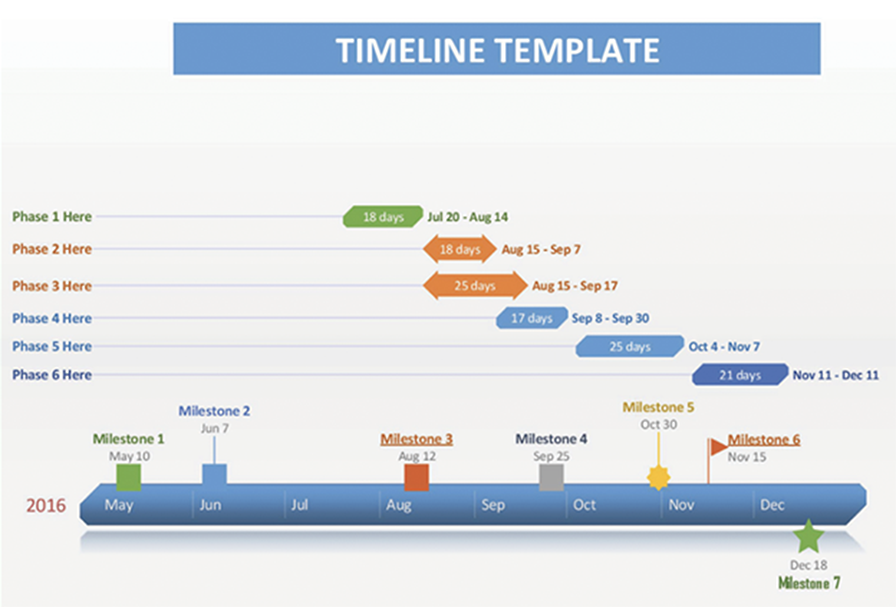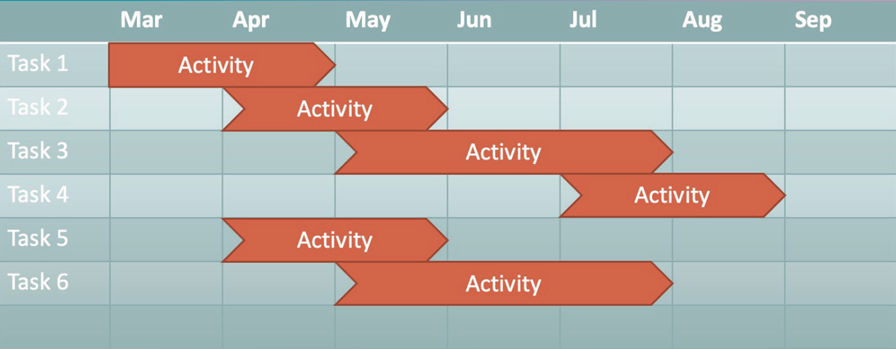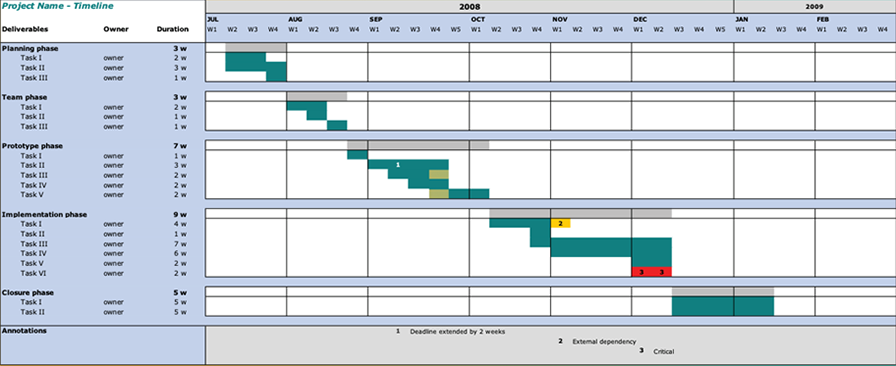The project Work Breakdown Structure (WBS) and Human Resource Management (HRM) policies, procedures, methods, tools, and techniques are critical inputs to planning and acquiring project human resources.
In this chapter, you examine how you can use a project WBS to identify required human resources and how HRM policies, procedures, methods, tools, and techniques can assist you in their acquisition.
By the end of this topic, you will understand:
- project documents and plans which define the human resource planning
- how a work breakdown structure (WBS) assists in planning for project human resources
- HR policies and procedures relevant to the acquisition of project human resources
- Human Resource Management (HRM) methods, techniques and tools for acquiring and managing human resources.
The first step in Human Resource Management is to identify the human resources required to get project work done based on the overall project plan and the work breakdown structure (WBS), which lists project tasks and activities. Secondly, you must organise to acquire the planned resources. Thirdly, you will need to consider the development and training needs of the project team and then lead and manage the team to complete the project work.
Human Resource Management (HRM) policies, procedures, tools, and techniques should inform and support your work as a Project Manager. Your workplace should have policies and procedures to help plan and manage your project's human resources.
Procedures can include:
- Recruitment procedures include how identifying job skills and creating position descriptions.
- Equal opportunity policies and procedures to ensure your selection processes do not discriminate against others
If the project is large and complex, a separate Human Resource Management Plan describing resource acquisition, roles and responsibilities, reporting relationships, and staffing management will be addressed, and structure may be developed.
Learn about Human Resource Plan Templates and access a free template from Project Management Docs.
For simpler projects, you can document the human resource requirements in the project plan by designating the relevant resource next to the relevant task.
Note
Be aware that you might inherit a team (in part or whole). Sometimes people are appointed to a project based on availability rather than specific skills. In this instance, it will be essential for you to ensure that the team is provided with any required training and development that is needed prior to commencing work.
Identify human resource requirements
Project documentation developed early on (such as the Project Initiation Document, which defines project requirements/deliverables including scope, budget, risk management, quality standards and project communications) provides information relevant to the planning and acquisition of project human resources.
Input from the earlier stages of the project initiation and planning will assist you in identifying project human resource requirements. This will include project planning meetings, discussions with stakeholders and team meetings.
In addition, the human resources department can assist with conducting skills or competency analysis used for roles based on the WBS. The skills analysis will give you a competency profile of what is required to fulfil the roles required within the project. This profile can then be used to develop position descriptions (PDs) which are used in the recruitment and selection process to match CVs to PDs.
Work Breakdown Structure (WBS)
A WBS is developed as part of the initial project planning and provides information about the project skill sets and roles required. These project skills and roles might include support staff, like an administrative assistant or a team leader, to support you in managing the team, as well as specialised staff allocated to specific project roles or tasks.
Watch What is a WBS for an overview of a WBS
Sometimes, you can use a WBS dictionary to define/specify deliverables related to specific tasks.
Read the instructions 12 things to include in a WBS dictionary from Project Engineer to learn how to create a WBS dictionary.
Example of a WBS for a small project
Each of the listed tasks in the example could be broken down further for more detail if required. The level of detail is whatever is required for you to be able to develop a schedule and determine the resources required. For each task listed, write down the resources required.
Read how to create a work breakdown structure by reading the article What is work breakdown structure?
Project task schedule and timeline
Based on the project WBS, you can now prepare a task schedule that defines the project’s milestones, activities, and deliverables, with intended start and finish dates, all of which will indicate the required resources.
GANTT Charts
Gantt charts are a popular tool in project scheduling and project managing and are basically a table. They can be produced in MS Word, Excel, PPT or Google docs.
A GANTT chart is basically a horizontal bar chart that shows project activities and tasks in sequential order and the estimated time to complete tasks.
The chart shows the time relationship of activities, tasks, milestones, and resources in a project. It can also be adjusted throughout the life of the project.
Examples of timelines and project schedules
Here are some examples from freely available templates online for you to consider.



TemplateLAB has 18 free timeline templates (Excel, PowerPoint, Word, PSD that you can use in project management. Review examples of their completed timeline templates.
Watch
Watch this YouTube to Learn how to make a timeline in google docs
Project management software
Project management software can be used to manage project human resources. The software can be used to allocate tasks and due dates. Gantt charts, pie charts and work-in-progress reports can be developed in some systems. To see a list of software available, visit Project Management Software
Plan resources
Based on your work preparing timelines and schedules, you will be able to assess and confirm the resources and skill requirements for the project.
You will be able to:
- identify the project roles required
- determine the reporting relationships needed
- provide guidelines on the lead time required for resourcing the project
- identify any risks associated with human resourcing.
Once you have calculated your project's human resource needs, it is advisable that you seek the help of HR professionals and/ or the Procurement Department in your organisation to assist you with the acquisition of resources. This can include advice on contracts and items which must be included, for example, termination for non-performance.
It is important to reinforce that HR operates within a regulatory framework, and you must follow organisational policies and procedures in matters related to human resource acquisition. Seek advice from the HR hiring manager about policies and procedures and important considerations such as Workplace Law. You can also access information readily online from the Government agencies responsible for regulatory matters.
Some of the initial decisions that you need to consider when acquiring human resources are:
- Will all project staff be full-time?
- Are external contractors/consultants an option?
- Are there available internal resources with the right skills/capability?
- What does the project budget allow for in terms of cost?
- Does the procurement department need to be involved?
- What are the policies and procedures regarding employment contracts? For example, is there a stipulation for a probationary period?
Clarifying these issues and questions will help to minimise risk in human resource acquisition. A simple table format can be used to organise and track the acquisition, as shown in the table below.
| Name | WBS Task/s | Full/Part Time (hrs) | Cost | Recruitment Procedure | Internal/External | Lead time | Resp for hiring | Approved |
|---|---|---|---|---|---|---|---|---|
| John Smith | Learning Designer | 20 hours per week | $100/hr Total for 6 weeks $12,000 |
|
External | 2 weeks before start date: 22/11/2022 |
|
✓ |
Watch
Watch What is HRM (Human Resource Management)? by Eye on Tech to learn about human resource management function and project resource management.
Further Reading
Read What is the employment law in Australia? by employsure to find out more about legislation, industrial instruments and common law.
Review the legislation from the Fair Work Ombudsman that governs Australia’s workplaces.
When assigning project tasks, you must carefully consider the skills and knowledge of both individuals and groups. In addition, you must be clear about what each role requires to successfully complete the project.
Further Reading
Read the following article How to conduct a skills gap analysis by Resources for Employers to help you identify the skills needed to meet your business or project goals.
Job description
A job description can also be called a position description or job and person specification. It Is used to provide an outline of the role, responsibilities and skills and knowledge required to perform the duties.
A job description identifies:
- Job title
- Employment type (full-time, part-time, casual or contractor)
- Location
- Reporting relationships
- Main duties and responsibilities
- Skills and experience required, including qualifications
further Reading
Read how to create a job description and access a free Job Description Template by Betterteam that you can download and customise to meet your requirements.
Once you have a role description and/or a position description, you can, with the help of HR, solicit CVs from prospective applicants and follow your organisation’s recruitment and selection process for both external and internal candidates to select your team based on your skill and knowledge requirements.
Behavioural interviewing
Behavioural interviewing is an HR technique used in the selection process to determine whether a candidate has the required skills and knowledge for the role.
Behavioural interviewing requires a candidate to speak about actual experience and is an effective interviewing tool because it is likely that past behaviour is a good indicator of future behaviour.
Behavioural interviewing requires the candidate to apply the STAR technique to describe a particular experience in the following terms:
- Situation – what was the situation they were in?
- Task – what was the task they had to complete?
- Action – what was the action? What did they do to fulfil the task?
- Result – what was the result of their action?
further Reading
Read five common behavioural interview questions by Randstad to review examples of behavioural questioning techniques that apply the STAR technique.
Induction
All new employees must attend an induction into the workplace. This ensures that you meet your work health and safety obligations and that the employee feels welcome in their new role.
An induction can include:
- Introductions to key staff
- Orientation of the workplace, including kitchen and toilet facilities
- Overview of the organisation
- Induction into the job role, key tasks and reporting relationships
- Hours of work and breaks
- Pay and award
- Policies and procedures
- Work health and safety induction
- Technical training for the job role
Once you have the planned work outputs and timelines for the project, you can select the human resources required. At this point, the resources you require can be allocated to the tasks included in the project plan/schedule. Below, you will find an example of this.
A human resource plan details the processes used to manage human resources.
The HR plan includes information about:
- Roles, responsibilities and necessary skills and knowledge required of team members
- Organisational chart
- Training and development gaps and training strategies
- Recognition and rewards
The steps to develop an HR plan include:
- Develop clear roles and responsibilities – define all roles and responsibilities required for your project
- Develop an organisational chart – if there is not an existing organisational chart, develop an organisational chart to show a visual representation of teams and reporting relationships
- Create a staff strategy – review the existing roles which can be filled within the organisation and positions that will need to be advertised for you to recruit an external candidate.
- Develop training and development strategy – review the existing skills and knowledge of staff and develop a training plan of potential training requirements. Identify any compulsory work health and safety or compliance information that must be included.
- Recognition and rewards – identify ways that you will reward teams and individual team members
- Resources required for the team – consider any resources that staff will need to access to complete their project roles. Resources may include physical space, computers and printers.
You will need to develop an HR Plan as part of your assessment. Read the article Human Resource Management Plan Template by Project Practical for more information about HR plans and to download a free template.
